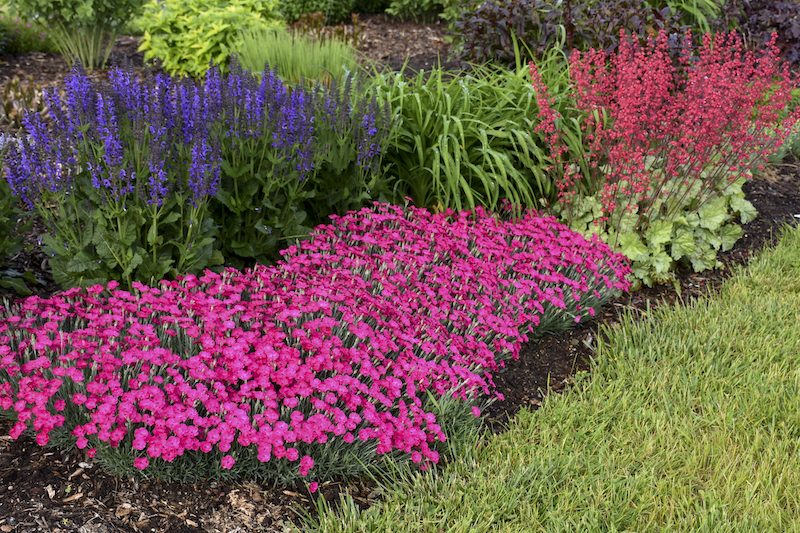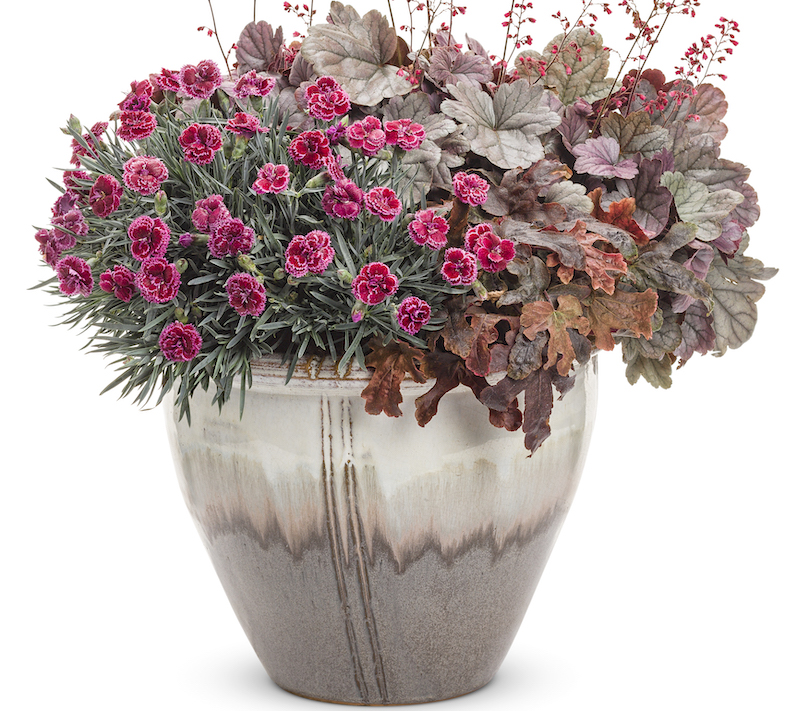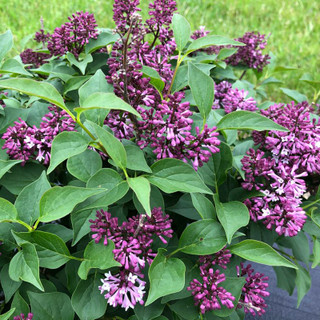Dianthus grows mainly as a perennial in a variety of conditions that range from heavy clay soil to sandy loam. Dianthus (also known as cottage pinks and sweet william) have a very long flowering period from late spring through summer and often impart a heady fragrance that is hard to resist. Pairing other plants with Dianthus is quite easy due to its nondemanding growing preferences.
It prefers well-draining, neutral pH soil, and a consistently moist location. Use Dianthus to add a pop of color in a gravel garden, an alpine collection, or a low-growing border for a perennial garden bed. You can also mix it with other scented and tactile plants as part of a sensory garden design.

There is a Dianthus that is perfect for just about every garden in USDA growing zones 4-10. Gardeners in colder zones can plant Dianthus as an annual plant or overwinter it in a frost-free location such as a garage or cool basement. Place Dianthus in a location with at least 6 hours of full sun exposure to produce the most and largest flowers.
Shrubs To Plant With Dianthus
Early spring and summer blooming Dianthus make an effective ground cover when planted at the base of deciduous and evergreen shrubs. The lovely scent and cheery color of this prolific bloomer attract beneficial bees, butterflies, and hummingbirds to help create a wildlife-friendly landscape. Ninebark, Forsythia, lilac, and shrub roses are some fantastic deciduous shrubs that typically benefit from having a lower growing layer to cover and dress up any bare stems. Evergreen shrubs grown as foundation or hedging plants will look bright and cheery having a seasonal and low-maintenance ground cover of Dianthus.

Perennials To Plant With Dianthus
Dianthus can be quite drought tolerant when mature and well established. Pair this plant in hot colors with Red Hot Poker, sage, or perennial Verbena for an intense summer display in full sun. Perennials that prefer slightly more shade such as coral bells, peony, or columbine will get a punch of color when placed behind the lower-growing Dianthus. Even though carnations may not be as hardy as other types of Dianthus, they are perennial in USDA growing zones 7-10 and tall enough to be the perfect backdrop for shorter late-spring bulbs, Iris and Delphinium.
Annuals To Plant With Dianthus
Dianthus are great fill-in plants for the garden during the transition from spring to summer when the bulbs may not be at their best, but not ready to cut back yet. Plant Dianthus, snapdragons, Alyssum, and pansies for early spring color that lasts until the hottest days of summer. Planting Petunias, Angelonia, Calibrachoa, and Veronica with Dianthus ensures a bright display of flowers until the first frost in fall. Any annual plant that appreciates full sun and moderately fertile and moist soil will be a successful pairing.
Best Companion Plants For Dianthus in Containers
Dianthus works in a mixed planter beautifully. The grass-like foliage and dainty flowers are a perfect filler plant to highlight or contrast with other more dramatic bloomers. A combination of coral bells, Dianthus, and foam flowers is a great combination that looks delicate while having a long bloom period. Dianthus is well-behaved when grown in containers, with little risk of it overgrowing its neighbors. Fertilize the container with a slow-release feed at planting time to provide a consistent level of nutrients through the growing season.

Plants Not To Grow With Dianthus
Although Dianthus is one of the most versatile plants for the garden bed or planter, there are a few considerations when choosing the right plants to grow with it. Plants that thrive in extremely dry or hot climates will not be the best choice. Cacti, succulents, and yuccas prefer far less water than Dianthus needs for proper blooming. Growing Dianthus in very shady locations alongside Torenia, Lobelia, or Impatiens will restrict Dianthus blooms. Over time, the general health of Dianthus will decline, making the plant more susceptible to pests and diseases.
Also, be mindful how different colors play off each other in a design. The deep reds or magenta pinks of Dianthus are easy to pair in a monotone design but may look very different when paired with calmer shades of pale yellow, blue, or white.
Best Plants To Grow With Dianthus
Plants that prefer well-draining, consistently moist, moderately fertile soil are the best choices for growing with Dianthus. Dianthus looks great grown in conjunction with perennial Salvia and mid-sized coral bells. In this combination, the flower spikes of deep purple and rich red are grounded by the brightly colored flowers of Dianthus as a border. Use dianthus as a groundcover for ninebark, forsythia, lilac, and roses in a coordinating color.
 |
Author Robbin Small - Published 9-07-2023 |




